

Newsletter
Issue 63 1983 ~ 2008 August 2008


Table of contents
Newsdesk, and dates for your diary 2
Museum Update- 4
Merton Abbey Mills update 9
Members Visit to Kew Bridge Steam Museum 10
The Great Stink of 1858 and the R. Westbourne 12
~~~ NEWSDESK ~~~
Visits to the Museum
We have been pleased to welcome many visitors to the Museum during June, July and August to help us celebrate our Silver Jubilee and 25 years of the Wandle Industrial Museum.
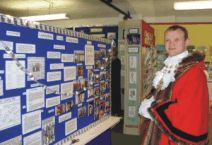 The Mayor reviews the new exhibit
The Mayor reviews the new exhibit
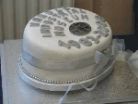 The ‘silver’ celebration
cake
The ‘silver’ celebration
cakeEvents On Saturday June 14th our new Exhibition "Looking Back — Looking Forward" created by our Volunteer Curator Meg Thomas was opened by the Mayor of Merton, Cllr Martin Whelton. Many members and guests attended the ceremony including Cllr Maurice Groves, Cabinet Member for Community Services, Cllr Stephen Alambritis, Leader of the Labour Councillors for Merton, and Vicki Carroll of the Wandle Valley Festival. Following the Exhibition opening, the 25th Anniversary cake was cut and refreshments were served, prepared once again by Mary Hart. Our thanks to all those who helped to make this occasion a great success. Our special silver anniversary visitors book was opened for the occasion and will be shut after 1 year, so we hope all will take the opportunity to visit us and sign it over the coming months.
Outreach Mary and Nicholas Hart were busy representing the Museum once
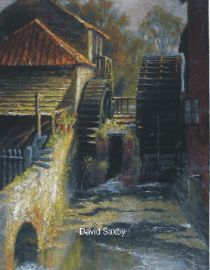 Mills of the Wandle cover
Mills of the Wandle cover
again at Merton Abbey Mills as part of the Wandle Valley Festival over the weekend of 7th/8th June. Printing activities in the Chapter House proved very popular with the many visitors to this annual event.
On Saturday June 21st we had a stall at the Wimbledon Village Fair. This was a very successful day, raising nearly £100 mainly due to sales of the new publication "The Mills of the River Wandle" by David Saxby, partly funded by the Museum. This book is proving very popular. Priced at £2.95 it is a small A5 book illustrated with colour photos of the mills and a brief history of their varied uses over time. If you have not yet bought your copy we urge you to do so.
Members' visit to Kew Bridge Steam Museum
Illness prevented my attending this event, but I understand it was a successful outing. (See articles by Eric and Meg.)
Dates for your Diary
• Tuesday 23rd September at 2pm: Open Afternoon at the Museum as part of Merton's Festival for the Over-Fifties. Once again we are happy to participate in this annual event. Join us for a film, tour of the Museum and a cup of tea — but ring to book your place!
• Wednesday 1st October: next Volunteers' Lunch at 12 noon. All Volunteers welcome.
• London Open House Weekend - 20/21 September - Mary will be on duty in the Chapter House all weekend with her printing demonstrations.
• Our Annual General Meeting will be on Thursday November 27th at 7-30pm at Raynes Park Library. The speaker will be Simon Lace, Curator of Maidstone Museum & Bentlif Art Gallery in Maidstone, who has been our Curatorial Advisor for the last ten years We do hope as many of you as possible will be able to attend.
Sheila Harris 20/8/2008
MUSEUM NEWS
Curators Report.
We have gained provisional Accreditation and are now working on the areas we need to improve. The big task facing us is collection care. Although we have taken care of the artifacts we hold the museum standard of care is very different. The back office must be rearranged to allow us to create an area that can be
sealed off from the rest of the office in which to store the artifacts. We also need to upgrade how our artifacts are protected, this means purchasing museum quality protective materials. We are hoping to make use of a grant offered by the MLA to carry out this work. Fortunately we don't have to do all the work at once, but we do have to submit a plan showing how we will carry out the task.
I took some of our snuff bottles to the V&A to find out more about them. Sadly they are not rare ancient Chinese bottles but most of them are Chinese.
Meg Thomas, Aug 2008
Skeletons:
For about another 4 weeks the more morbid of us can visit “London's Buried Bones” at the Wellcome Collection, 183 Euston Road, NW1 (020-7611 2222) - open until Sept 28. Free entry but by ticket, so booking essential. For more detail go to www.timesonline.co.uk and put ‘wellcome bones’ in the search box for all the articles. The Wandle features because some of the bones come from Merton Priory.
We have been donated a simple yet important piece of our industrial heritage. The label now reads:
SLUICE GATE KEY
RAVENSBURY MILL
Handed to David Bolton, original resident of 22 Island House, Ravensbury Mill in c 1996 by workmen as they left the site on completion of the development with a request for him to hand to Wandle Industrial Museum when it moved in. Handed over by him June 25, 2008 on selling the flat and moving to the Cotswolds.
From The Times, 23/7/08 (Times2, p21) “For anyone with an interest in human life, this is a compelling show. Added poignancy is given by Thomas Adank's photographs, inevitably mundane, of the various burial sites as they now appear: an anonymous housing block in place of Cross Bones; a branch of Pizza Hut where once Merton Priory stood.”
Our own Sheila Harris, who visited this exhibition with the History Society, was also sufficiently impressed to want a second visit. TimeOut says ‘This is by some distance the the most intersting and best prsented exhibition currently on in London”!!!
Ravensbury
In the last couple of weeks our eventual move to Ravensbury has taken an enormous step closer.
You will no doubt recall that one of our problems has been that a change in rules by the Heritage Lottery Fund (HLF) about the type of lease a heritage body needs to have before it can apply for a major grant stopped our last application in its tracks. After some persuading from us, HLF bent over backwards to bend their rules, and agreed we could move on provided LB Merton signed a simple agreement with them.
Extract from Note prepared for MLA as part of our accreditation process
Ravensbury Mill. We are the named beneficiaries of a s106 agreement that compels the freeholder to grant us a lease for 125 years at a peppercorn for a fully renovated building. Effectively we already have a 'signed tenure' for that building, it is just we choose not to move in whilst works are outstanding.
That choice is for very sound financial reasons. Once we sign the lease itself, we become bound by its covenants, and any that the freeholder has left unperformed would become contractually ours. We estimate that the costs associated with completion of works may come to £50,000. As you will know, grant money is never available to plug the hole for a third party's financial obligations.
They provided the draft for this in 2005, and at a meeting a few days ago LB Merton have confirmed to HLF that they will be happy to sign this document as a pre condition to us receiving major grant funds.
At last we can move forward, and with Cllr Maurice Groves pushing hard for resolution of the s106 problem (see box), there may yet be light at the end of the tunnel.
Needless to say the HLF rules for major grant applications has changed in the last 3 years. In a development from the early days, when only large organisations with trained staff were likely to overcome the technical complexities of application, HLF had introduced Project Planning grants (up to £50,000) so organisations like ours could employ someone to do this for us. HLF had advised, in effect, that it was a lack of those skills which had failed our first two bids, and were politely suggesting this as the way forward. It was in the course of this application that the bombshell about the lease stopped us in our tracks.
Now that too has gone to be replaced by a 3 stage process. The first (not obligatory) stage is the pre-application. This is meant to be a relatively simple form a review of which allows HLF to indicate to prospective applicants whether they are wasting their time. This form includes the helpful summary:
"To receive a grant your project must:
- Help people to learn about their own and other people's heritage.
Your project must also do either or both of the following:
- Conserve the UK's diverse heritage for present and future generations to experience and enjoy.
- Help more people, and a wider range of people, to take an active part in and make decisions about heritage."
Although this looks obvious, and a shoe-in for us, we are taking no chances and starting to put this form together. This is not as simple as it could be, and requires levels of detail intended to prove we already know what we are talking about, and that our aims are clear.
This is a bit of a volte face, because it reverses what they advised us when our last bid failed - one of the main benefits of the Project Planning grant was to get specialist help to test whether (amongst other things) our aim of moving to Ravensbury was right for us. Now our pre-application form asks us to be quite specific about what we are trying to do.
A successful pre-app then leads to a stage 1 bid. This is roughly equivalent to the Project Planning bid, except that the forms and documentation used can be re-used, fully implemented, in the stage 2 bid.
Some of the rules have changed in our favour, in that the old limit of £500,000 for grants which can be reviewed by the quarterly HLF committee meetings has now been raised to £1,000,000. Above that figure the relevant committee meets only annually. It is not that we will bid that high - the £500,000 budget for the last bid may still be all we need, but that we will look more like an average bid, rather than a special one which pushes the limits. In a further development HLF will now assign us a mentor (previously they were meant only to assess bids, and therefore felt they could not actively assist in the preparation).
On the downside, London 2012 has resulted in a halving of the budget for our class of bids, so we must be even more competitive if we are to proceed, highlighted by the warnings now issued that achieving a stage 1 bid successfully in no way increases the odds for a successful stage 2 bid (the opposite of the equivalent position 3 years ago).
Our pre-app document will be reviewed by the committee in our meeting later in September, and the HLF should let us know that we can progress quite quickly after submission.
If all goes well by this time next year we could be waiting for the results of our stage 1 bid!
WIM in the news
The local papers are beginning to pick up on our activities at last. For example the following appeared in the Guardian on 26 June edition (in Eco News!)
MUSEUM ANNIVERSARY: The Wandle Industrial Museum celebrated its 25th anniversary last weekend.
To mark the occasion the mayor of Merton. Councillor Martin Whelton joined dignitaries for a champagne buffet and cake cutting ceremony.
A new exhibition was also launched, “Looking Back1983-2008 Looking Forward”.
Meg Thomas, the museum's curator, said: "We are delighted that so many people have come to our celebration. We have survived 25 years and everyone is determined it will continue for another 25 years.”
Wandle Valley Festival 2009
Following the success of this year’s event over a full weekend, the date for next year has been provisionally booked as the weekend of 6/7th June 2009.
Our first planning meeting will take place towards the end of September, so anyone with views about what went right, what went wrong, and what was missing would find their input much appreciated. Please write to us at the Museum or email wvf@wandle.org.
Merton Abbey Mills Update
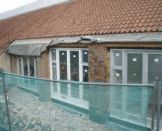 The new Windows at the
Long Shop
The new Windows at the
Long ShopThe Market - We have heard that, in a continuing attempt to ensure that the market pays it’s way to protect its future, it is now to be integrated with the entertainment (theatre and bandstand) and the retail units under the management of Peter Wallder of the Colour House Theatre, the main mover behind the Abbeyfest which has just finished another successful run. John Hawks, who has run the market as a labour of love for the last couple of years, is not abandoning the Mills, but continuing to be involved with the Priory Trust, Chapter House and Wandle Valley Festival as well as his series of evening concerts.
Long Shop - We have already commented on the sadness of losing the wonderful curved window arches at the Long Shop, with their modern replacements no doubt much more efficient, but somehow making an aesthetic change that is far more fundamental than expected.
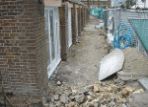
The Long Shop east side
However, this does not stop here. A Planning Application Number 08/P2018 at LB Merton alerts us to the proposal for the insertion of 14 rooflights into the existing roof [7 in the west elevation and 7 in the east
Elevation]. This would be a great shame, and would consolidate the impression that this was no longer one integrated building (the whole point of the Long Shop), merely a succession of 7 units which happen to be joined together. If there is a lighting problem, surely the efficient use of the existing rooflights in combination with creative use of Light Tunnels would be more effective, and help preserve what’s left?
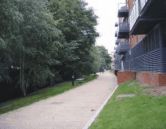 Bennetts Ditch
Bennetts Ditch
Typical light tunnel
Light tunnels
Sunlight coming from different directions is absorbed by a dome installed on the roof. The dome directs the sunlight into a tubing, which is made of the highest-quality reflective material with an increased reflection coefficient. Then, by way of mirror reflections, the light is transferred to a prismatic or matt diffuser. Nonpolarized light coming into the room brightens the area evenly, and does not cause reflexes on smooth surfaces (e.g. monitors, screens).
Irrespective of the outside weather conditions, the light in the room has much higher colour rendering index (warm light) than any other source of an artificial light.
Landscaping
On a more positive note, the landscaping along Bennetts Ditch appears to have settled down remarkably well, and has not become the overgrown mess we feared.
Members and Volunteers visit to Kew Bridge Steam Museum, 26 July 2008
On 26 July 10 Museum members and volunteers met at the Kew Bridge Steam Museum. During the visit we saw five of the larger stationary engines running, and were told the history and working details of three of the engines before they were put into motion. There were several smaller engines and quite a few model engines as well.
In addition there was a large water wheel working, which was originally located at the Duke of Somerset’s estate where it powered pumps to pump water from the River Frome in Dorset to supply his estate and the village drinking fountain at Maiden Bradley.
I found the visit very interesting because during part of my apprenticeship I worked on boilers and associated machinery similar to that displayed.
We have some of the Steam Museum’s current leaflets in our shop area, so it’s possible to see what’s on offer during a visit.
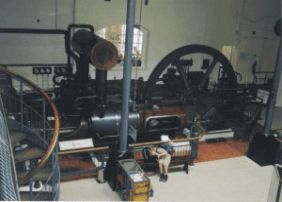
The photo is of the Waddon Engine, which wasn’t running when we visited. It’s a two cylinder cross-compound engine. I took the photo because Waddon is fairly local to where I live. The site of the pumping station is now occupied by the bowling green of the Croydon Municipal Officers Bowling Club.
If, like me, you have a Freedom pass it costs nothing for the journey to and from the Museum as it is very easy to get there by public transport.
Eric Shaw, August 2008
Wheel End
Meg Thomas writes:
On our recent visit to Kew Bridge Steam Museum we met volunteer Ivan Fear a sprightly 80 year old.
Ivan has a unique connection with the water wheel that is one of the working exhibits. He was born in Maiden Bradley , Somerset, part of the Duke of Somerset's estate.
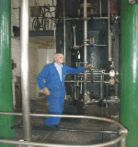 Ivan Fear, the engineer,
starts the 90" pump for
us. Later he was to run
the waterwheel for us
Ivan Fear, the engineer,
starts the 90" pump for
us. Later he was to run
the waterwheel for usIvan's father was waterman to the Duke and maintained the water wheel. The water wheel was used to pump water from the River Frome to supply the Duke's estate and the village of Maiden Bradley. When Ivan was two weeks old he was given a drink of the water that the wheel was pumping and was hooked! The wheel's role came to an end and the wheel was left to decay.
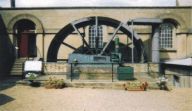 The Duke of Somerset’s
waterwheel (photo Meg Thomas)
The Duke of Somerset’s
waterwheel (photo Meg Thomas)Fortunately this tale has a happy ending. The sad state of the wheel was noted and Ivan was persuaded to write to the present Duke of Somerset and ask if the water wheel could be donated to the Kew Bridge Museum, the Duke readily agreed and the wheel was duly brought to the Museum. By now the wheel was in a very poor state so a fund raising scheme was started, people were asked to buy a paddle, the wooden cross piece attached to the wheel against which the water runs to turn the wheel. The wheel needed seventy paddles. The appeal was successful, the last paddle being purchased by Ivan's daughter.
On 17th of July 1993 the Duke of Somerset officiated at the opening ceremony, and the wheel has run on open weekends ever since, tended by the son of the original waterman. A neat ending.
Aug 2008
The Great Stink of 1858 and the River Westbourne
Seemlessly linking from the articles about our visit to Kew Bridge Steam Museum, one of this year’s forgotten anniversaries is that it is 150 years since the Great Stink closed Parliament in 1858, and accelerated the sequence of events which led to a proper sewerage system for London, and the work of the great Joseph Bazalgette.
Consequent on this was the final culverting in of many of London’s now lost rivers.
For those who don’t know of the magnificence of some of this work, there are intrepid explorers who revel in the exploration of these areas, and the great brick lined caverns that run beneath London’s streets, and publish their work on the internet.
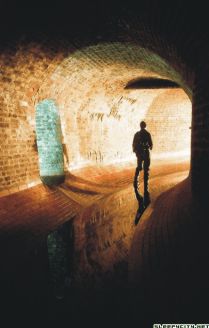 Underground images 1
Underground images 1
See eg, http://www.sub-urban.com/westbourne/ and
http://sleepycity.net/posts/110
The illustrations here are from one such website, and relate to the River Westbourne, which can currently only be seen by those visiting Sloane Square tube station, where it runs through a great pipe visible above the platforms.
This has become a matter of some interest both as a result of Boris Johnson’s stated intention of reclaiming the lost rivers, and the co-incidence of the demolition of Chelsea Barracks as part of a major residential development. The Westbourne runs across that site (under its other name - the Ranelagh Sewer), and it is not too late to hope it can be brought to the surface as part of the redevelopment.
This is more complicated than it seems, so we must go back 150 years to find out why.
Essentially Bazalgette constructed a great West/East sewer system (see map at end of this article), crossed at various points by the rivers, most of which had already become sewers in fact. What he did was to have these rivers drop sewage into the main sewer, but leave them in place as overflow pipes to deal with flash flooding. Most of the time these rivers are now pretty clean, but in storms such as we experienced last year these outfalls came into their own, and raw sewage was dumped down them into the Thames, causing much loss of fish and invertebrate life. The plan is from the Crossness website, which provides much useful background to this - see www.crossness.org.uk
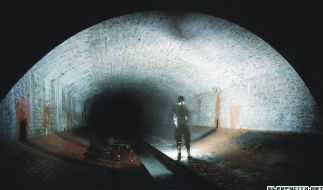 Underground images 2
Underground images 2Climate warming is predicted to increase the likelihood of such flooding, and Thames Water has decided to deal with it by constructing a new sewer to be known as the Tideway Tunnel, running down the banks of the Thames from Hammersmith to Crossness, some 75 foot underground. This will act like an enormous overflow pipe, and will supersede the need for the lost rivers to have that function. It will take until 2020 for this to be operational (amusingly the work will not start until just before the 2012 Olympics, so we must hope they have planned this properly, especially as there is to be a spur of this tunnel which starts at Stratford up by the Olympic park!
For those who wish to know more, the Thames Water web site www.thameswater.co.uk has a short online video you can watch.
But returning to the Westbourne, it seems unlikely that its clear water can be separated from the sewage early enough to be part of the current Chelsea Barracks redevelopment, but that doesn’t mean the layout for that site cannot be adjusted to allow for it to be brought to the surface in 15 years or so when the Tideway Tunnel starts to do its work.
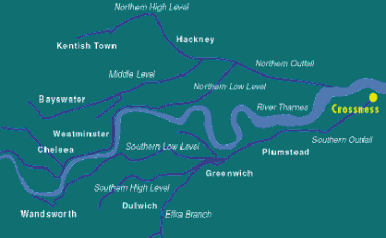 Bazalgette’s system
Bazalgette’s system
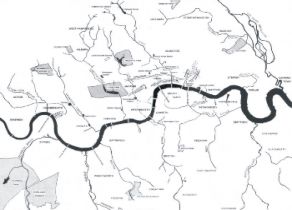 The lost Rivers of London
The lost Rivers of London

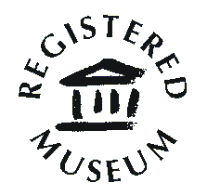
The Vestry Hall Annexe, London Road, Mitcham, Surrey CR4 3UD
Tel: 020-8648-0127
~~~~~~~~~~
OPEN: Every Wednesday 1 ~ 4 pm;
First Sunday of each month 2 ~ 5 pm.
~~~~~~~~~~
The Museum is also open to schools and groups by appointment.
~~~~~~~~~~
Admission: Adults 50p, Children & Senior Citizens 20p
The Wandle Industrial Museum would like to point out that the views of contributors to this newsletter are not necessarily the views of the Museum. We would be happy to give the right to reply to anyone who finds the content contentious.

